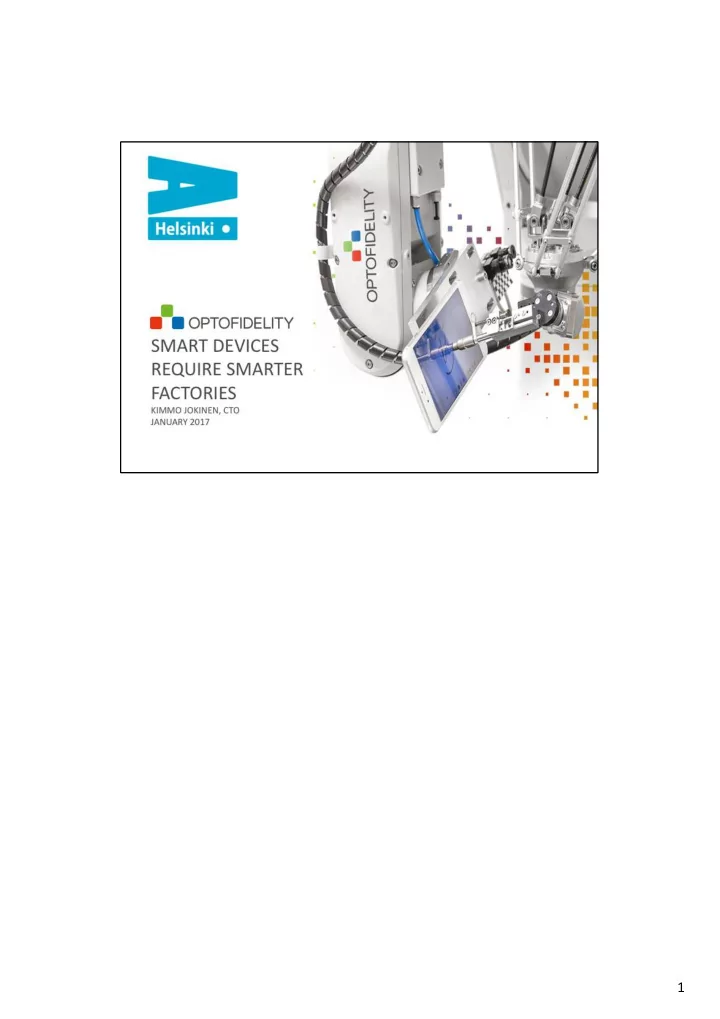

1
Greetings from Tampere! I am Kimmo Jokinen, the Co-Founder and CTO of OptoFidelity. Thanks to AIHelsinki and the Curious AI for inviting me here. Before founding OptoFidelity, I worked many years in Honeywell in Jyväskylä, developing intelligent camera systems for paper industry’s quality and runnability purposes. I also worked couple of years in Atostek, a software company from Tampere. I have strong machine vision and measurement technology background. I earned my masters from TUT in 2007. I describe myself a techno-maniac; meaning that I am obsessed about technology, but at the same time, I am very critical about the user experience. Currently I am working very passionately with VR and AR performance field. Co- creation with for example Google Daydream-team and Oculus’s research teams has been very important driver for the development. First fully automated VR performance testers are shipping in just few weeks, so I am happy, that OptoFidelity, the odd bird of test automation, again expanded its playground. 2
My views come from smart devices testing sector. I have been involved in innovating the testing solutions for multimedia devices RnD for over 10 years now. I have had the opportunity to co-create with companies like Google, Atmel and Intel. That artificial head in the picture, it represents the most recent, advanced thinking among the wearables testing. That is the first solution, capable of testing all VR and AR devices. The increasing trend has been the emerge of sensors. Sensors are needed for sensing the user, her gestures and the environment. The performance of the sensors and applications is traditionally measured during product development. Sensor calibration and tuning is a new requirement, that has appeared to the production phase. I will tell more about that later on. Lets first talk about smart devices. 3
First of all, what is a smart device? Connected, autonomous, ubiquitous. This definition is from wikipedia. 4
I wanted to tweak this one… This is a definition, originally written by the late Mark Weiser. I just replaced the word computer with smart device. I think this is quite bang on definition. I like this quite a lot. For example: smart device like autonomous car, it lets you to do something else; play with your kids, work, or enjoy a movie. Smart device, like wireless keychain in your pocket, automatically opens the door when you put your fingers to the handle. At the point, when smart device starts to extend the unconscious, the technology can be called ubiquitous. OK so, let’s test the definition with a technology, that we all know, and what is considered to belong to smart devices category… 5
Virtual reality. This is where the technology is supposed to create inmmersive experiences, no need to create calm. No need to be quiet. So, with some extent, the purpose of the device defines how smart it is. At least if we stick with the definition. Now, let’s move on, towards the topic, smart factories. 6
I will start with an example from automotive industry. 7
Automotive industry is facing the biggest change in centuries. It is called Industrie 4.0. Quite many say, that it is not a revolution, though. It is an evolution, after computers, automation and robotizing in Industry 3.0. Megatrends: - Connected cars - Autonomous cars - Electric cars 8
What is in-avoidable: cars are going to be smart devices. They qualify in many ways with that category. You can do other things, while they autonomously drive. They can park remotely and pick you up, when required. By the way, this car is: Faraday Future’s FF91, the first production car. - Revealed in CES - It has 30 sensors for autonomous driving / safety - Possible to pre-order with 5000 $ deposit, will ship 2018 - BUT WILL IT CREATE CALM? 9
There would certainly be a need for automotive technology, that creates calm!!! 10
OK, let’s shift to the main theme - smart factories. I will explain with a couple of examples, why and how producing of things is changing. 11
What we see here, is actually the result of Industry 3.0, the emerge of automation and robots. This example is from automotive, but could be extended to any smart devices production. That sort of conveyor is not flexible, and those robots do not make it actually more flexible. The answer is isle, or cell. More flexibility needed due to many reasons: - More sensors in the devices - Tuning and calibration needed - More customisation – for example, it has been predicted, that at some point, car buyers shall have a direct connection to the factory floor. The reason is the required customisation. - PART4YOU project, AUDI, presents the production isles (AILS) with collaboration robots. 12
I will give another example from wearables category. The number of sensors is growing in all head mounted devices categories. There shall be eye-tracking, external sensors, displays and projectors, which are supposed to inter-operate seamlessly, producing the user a high degree of presence. 13
This amount of sensors require production-phase calibration and tuning, due to component variations and mechanical tolerances. It is the same trend that with cars with advanced sensors, like lane assistant function. They have to be calibrated, in factory, and also after any service actions requiring component replacements. 14
So lets wrap up the take-aways for you. Flexibility – for example by enabling device variants production. Phone personalization by laser markings. Cars with unique features and option combination. Calibration and tuning – using algorithms and software to harmonize the quality Optimize yield – by utilizing technologies like Just Noticeable Difference, and customer voice from the field. Multi-function testing – means that single tests are not carried out in separate stations along the production line, instead, they are combined in upgradeable test and calibration cells. 15
16
Recommend
More recommend